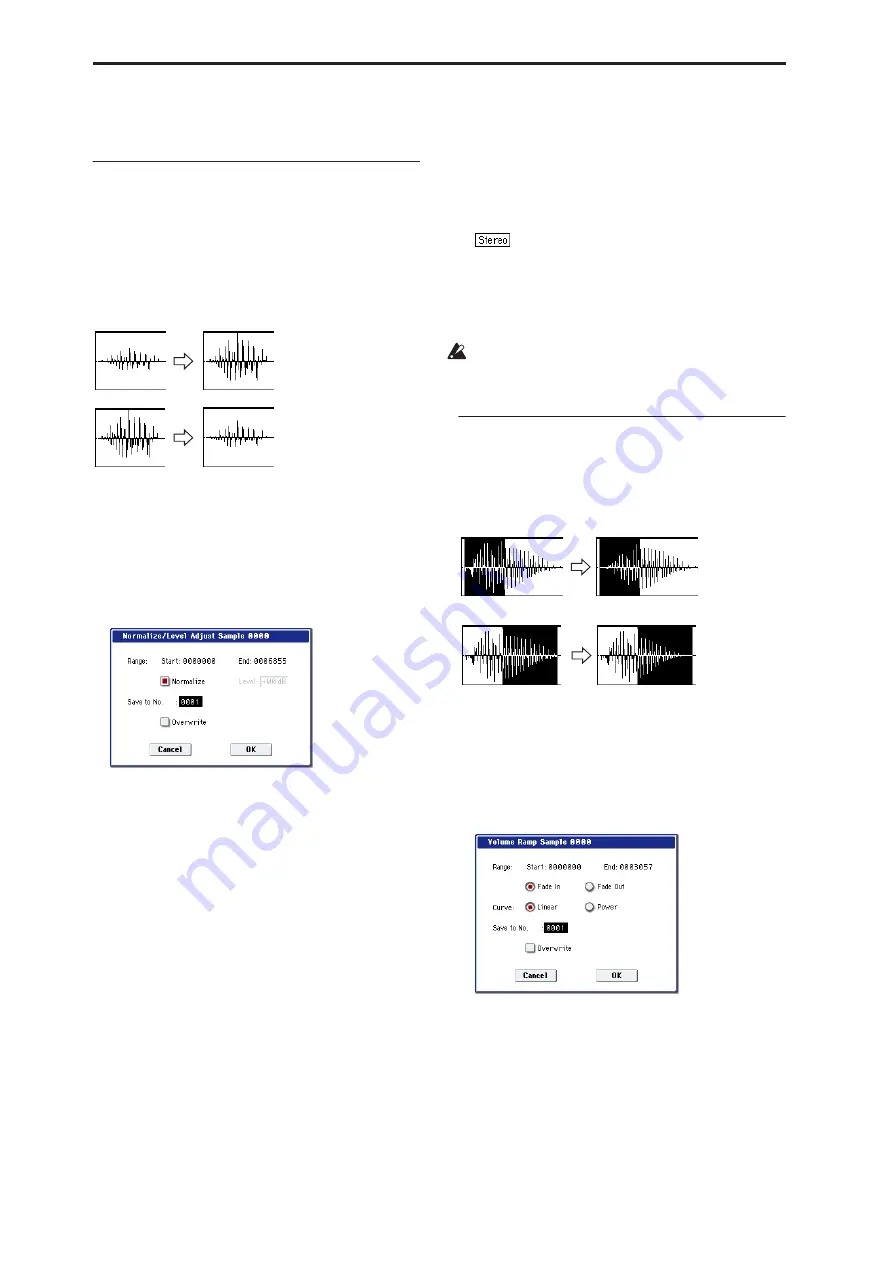
Sampling mode
626
6. To execute the Insert Zero command, press the OK
button. To cancel, press the Cancel button.
Normalize/Level Adjust
This command uniformly modifies the data values
(volume) of the data between the “Start”–“End.”
“Normalize” will amplify the level of the sample data
as far as possible without allowing it to clip (distort). If
the level of the sampled data is too low, you can
execute this command to increase the dynamic range.
Level
allows you to raise or lower the level as desired.
1. Use “Sample Select” (1–1b) to select the sample
that you wish to edit, and use “Start” and “End” to
specify the editing range.
You can press the SAMPLING START/STOP switch
or Play button to hear the portion that will be
normalized or level-adjusted.
2. Select “Normalize/Level Adj.” to open the dialog
box.
3. The range to be edited is shown by Range “Start”
and “End.”
4. If you check “Normalize” and execute, the data
will be normalized. In this case, the Level setting
will be ignored.
If you wish to specify
Level
to modify the level of
the sample data, do not check “Normalize.”
Each increase of +6 dB will approximately double
the height of the waveform shown in the LCD.
+12 dB will be an increase of approximately 4X, and
+18 dB will be approximately 8X. Conversely, each
decrease of –6 dB will halve the level, so that –6 dB
will be 1/2X and –12 dB will be approximately
1/4X. Executing the
Level
command with positive
(+) settings may cause the sound to clip (i.e., distort
at the point that amplification beyond the
maximum level is impossible). Once the sample
data has been boosted beyond the clipping point, re-
executing this command with negative (–) settings
of
Level
will simply lower the overall level of the
clipped signal –the waveform will remain distorted.
Also, if executing
Level
with negative (–) settings
causes any portion of the sample data to reach a
zero level, the zero data will not return to its
original state even if you re-execute
Level
with
positive (+) settings.
5. In “Save to No.,” specify the save destination
sample number. By default, an unused sample
number will be selected.
The sample number cannot be specified if
“Overwrite” is checked (page 615).
For stereo samples, use “Save to No.(L)” and
“(R)” to specify the save-destination of the L and R
channels.
6. To execute the Normalize/Level Adjust command,
press the OK button. To cancel, press the Cancel
button.
Be aware that if sample data of an extremely low
level is normalized, any noise included in the
sample will also be amplified.
Volume Ramp
This command modifies the data values (volume)
between the “Start” and “End.” You can make the
volume gradually increase (Fade In) or decrease (Fade
Out) from the “Start” to the “End.”
1. Use “Sample Select” (1–1b) to select the sample
that you wish to edit, and use “Start” and “End” to
specify the editing range.
You can press the SAMPLING START/STOP switch
or Play button to hear the portion on which
“Volume Ramp” will be executed.
2. Select “Volume Ramp” to open the dialog box.
3. The range to be edited is shown by Range “Start”
and “End.”
4. Use the radio buttons to select the type of volume
ramp.
Fade In:
The volume at Range “Start” will be zero,
and will gradually increase toward “End.”
Fade Out:
The volume will gradually decrease from
the Range “Start” volume until it reaches zero at
“End.”
Normalize
Level Adjust –6dB
Fade In
Fade Out
Содержание Electronic Keyboard
Страница 1: ...Parameter Guide Parameter Guide ...
Страница 2: ......
Страница 180: ...Program mode EXi 170 ...
Страница 290: ...EXi STR 1 Plucked String 280 ...
Страница 572: ...Sequencer mode 562 ...
Страница 700: ...Global mode 690 ...
Страница 751: ...Insert Effects IFX1 IFX12 Routing 741 Fig 2 3a Fig 2 3b ...
Страница 902: ...Effect Guide 892 ...






























